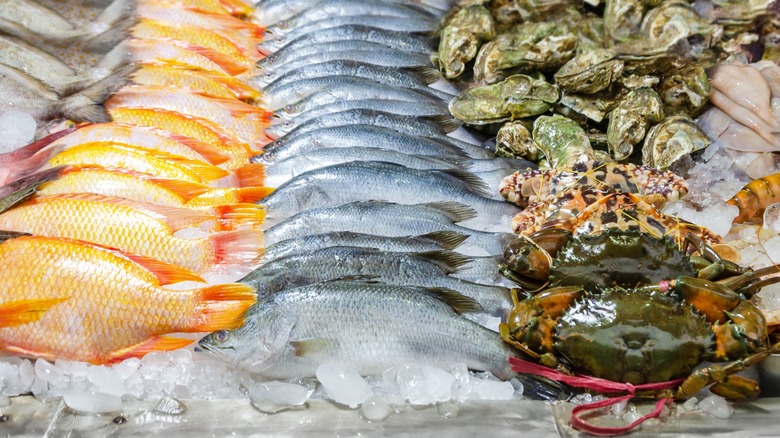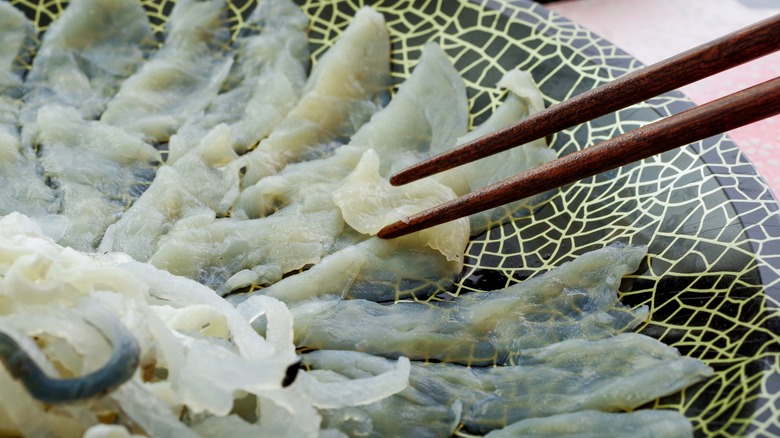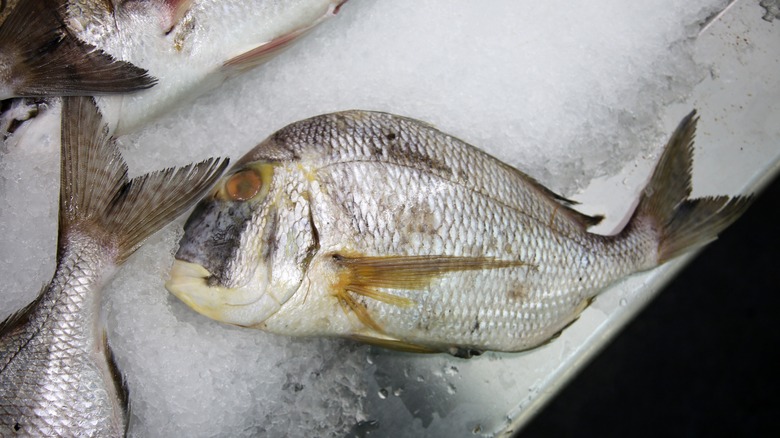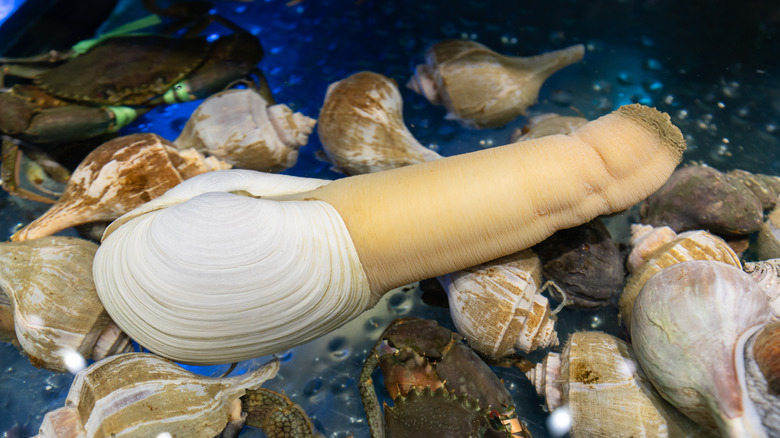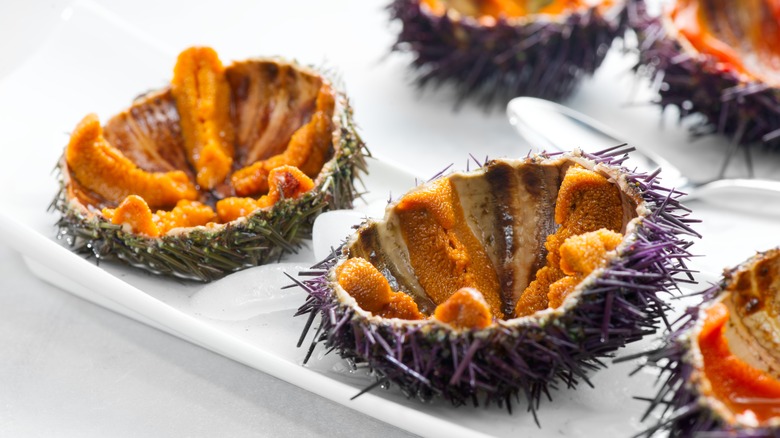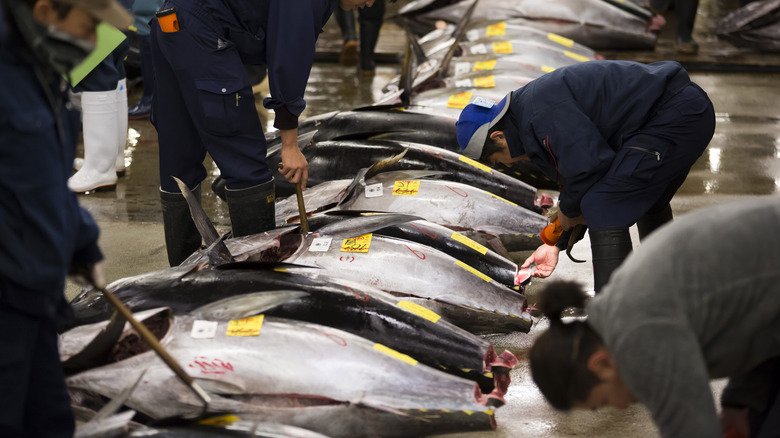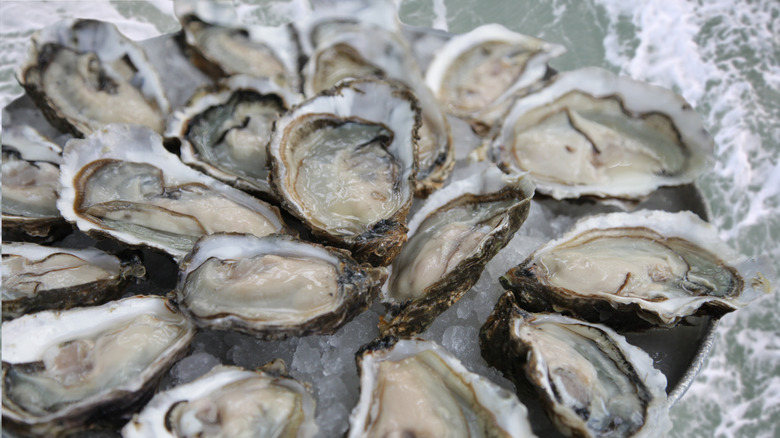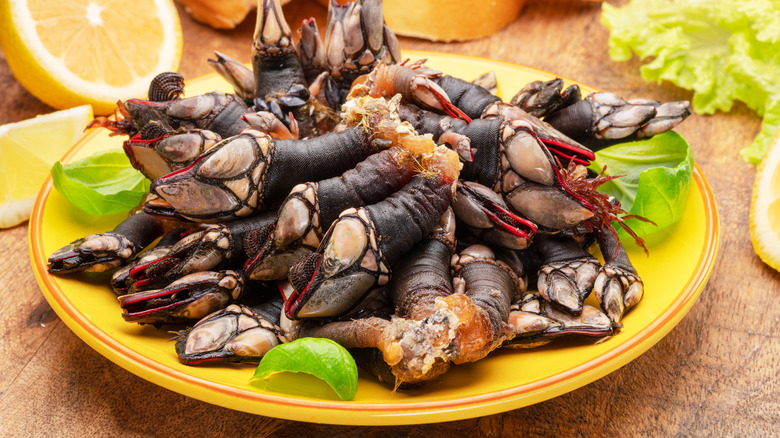You Must Try These 14 Seafoods Before You Die
The world's oceans are home to an incredible array of life that ranges from minuscule plankton to enormous blue whales. Despite this huge variety, the global consumption of seafood is focused on a relatively few species. According to a study performed by the National Fisheries Institute, just 10 species make up over 75% of Americans' total annual seafood consumption. Similar statistics abound elsewhere; the Marine Conservation Society reports that five species of fish account for 80% of all seafood sales in the United Kingdom.
High demand for these popular species often leads to overexploitation and negative environmental impacts. Aside from being detrimental to marine life in general, consumers' overreliance on a few species leads them to overlook some of the world's best seafood. This is a shame, as the world's oceans contain many animals that are significantly more interesting to eat than the regular serving of salmon, cod, or shrimp. We highlight this in the following article by presenting 14 of the most arresting kinds of seafood available. These animals boast an abundance of flavor, texture, and gastronomic appeal and should be tried before you die.
1. Whelks
Whelks are a type of marine snail that was a popular food in the U.K. during the Victorian era. During this time, the animals, which are still found in abundance off the nation's shores, were eaten as street food. Unfortunately, the mollusks have fallen out of popularity due to their reputation as a cheap food with a tough texture. This is not entirely true; when properly prepared and cooked whelks are firm, not rubbery, and boast a sweet flavor akin to other popular seafoods including scallops. As chefs Danny Ye and Rick Liang explained to Thrillist: "Whelks are very underrated. Their meat is sweeter, larger, and more plump than escargot or fresh-water snails. They're almost never used, and are worthy of restaurant menus in NYC."
Not only are whelks an enjoyable seafood, but they are also versatile. In South Korea, where whelks are viewed as a delicacy, the gastropods are served alongside soy sauce. At Boralia, a now-shuttered restaurant in Toronto, whelks were braised, grilled, and served with a beurre blanc sauce, proof that this humble seafood can attain impressive culinary heights.
2. Fugu
Taste, texture, and appearance are all reasons to try new kinds of seafood. However, some species offer more, attracting diners with the possibility of a unique or even dangerous experience. Fugu, otherwise known as blowfish, is one of these thanks to its status as the world's most poisonous fish.
Fugu's liver, gonads, and blood all contain a toxin called tetrodotoxin which can be fatal if ingested. For this reason, chefs in Japan — where fugu is most popular — must train for years and pass several tests before preparing or serving the fish. Fugu-trained chefs are incredibly skillful; they can break down the fish without spilling any of the neurotoxins. Being the beneficiary of such a skill is one of the reasons why so many people want to try fugu before they die.
That being said, it is reductive to view fugu as a novelty fish, one only made desirable due to its ability to kill. Instead, the fish should be viewed as a delicacy that, alongside its dangerous qualities, boasts a rare and impressive flavor. A taste that is attributable to the low levels of fat and high amounts of glutamic acid (which contribute to a strong umami flavor) that the fish's flesh contains.
3. Porgy
It's a sad fact that a fish's popularity largely depends not on its physical attributes, but on how it has been marketed. While the likes of cod and salmon have benefited from excellent marketing, other fish, such as porgy, have not been so lucky, as Todd Mitgang explained to Thrillist: "Porgy gets a bad rap for a lot of reasons: it's used as bait for bigger fish, and its name doesn't sound particularly classy. Porgy? Scup? I totally understand why this fish gets overlooked, but this needs to end."
As Mitgang alludes to, porgy has a far superior flavor and texture than its lackluster sales suggest. Many chefs, including Dave Pasternack enjoy using the fish, according to The New York Times. NYC chef Savannah Jordan claims that it has a great flavor that's similar to shrimp. Others enjoy the fish's firm, juicy texture and its ability to stand up to the liberal use of seasonings.
One of porgy's largest draws is its sustainable nature. The two porgy stocks found off the coast of North America are not overfished. What's more, porgy is used as a substitute for many other white-fleshed fish, such as cod, which suffer from overfishing. All of this suggests that — aside from being a fish you should try before you die — porgy is also a fish you should add to your regular rotation.
4. Geoduck
Geoducks are one of the world's many clam varieties. They are famed as being the world's largest burrowing clam and often attain weights of up to 16 pounds. These huge mollusks are found on the United States' Northwestern shoreline and are harvested from beaches at low tide. Usually, they are found three feet below the beach's surface.
As with several other seafoods mentioned in this article, geoducks are not widely eaten in the U.S. Instead, over 90% of the harvested clams are exported to Southeast Asia with China being a particularly large market. Here, the clams are prized for their texture, an engaging blend of crunch and toothsome chewiness, and their status as an aphrodisiac. Many chefs also celebrate geoducks' flavor, which is said to be clean, sweet, and mildly oceanic.
It is not geoduck's flavor or texture that has led many Americans to eschew this local specialty, but the animal's appearance. The clams are extremely phallic-looking, with a long neck and bulbous body. However, this intimidating veneer disguises that the clam is actually incredibly easy to prepare, as chef Brandon Jew highlighted to Eater: "They're actually very easy to clean. It's a quick blanch, and then you basically pull off the outer membrane. You can pretty much slice it and serve it from there." Once cleaned, geoducks are often served as sushi or in stews and soups.
5. John Dory
John Dory is an ugly fish. It is thin, has a large head, and boasts a row of spines along the edge of its body. What the fish lacks in looks however, it more than makes up for with taste; John Dory is a firm favorite of many chefs, including Rick Stein, thanks to its delectable flavor. Described as sweet-medium, the fish's flesh is notoriously robust and is well-suited to various cooking techniques.
Despite being prevalent in waters off the coast of various continents, John Dory has not gained widespread popularity. This is due to the fish's low yield. Thanks to its irregular shape, only 35% of each animal can be eaten. This strange shape makes fileting the fish a difficult task. To further complicate matters, the animal's meat is riddled with small bones. For these reasons, John Dory is best enjoyed in a restaurant, where the fiddly process of fileting and cooking is done for you. When eaten in these environments, John Dory is one of the most enjoyable fish in the world.
6. Sea urchin
There are nearly 1,000 recorded species of sea urchin. All are encased with a hard round shell dotted with an array of spines. Inside these shells lie the animal's organs. Of these, only the reproductive organs, known as uni, are edible. While eaten globally, these gonads are most popular in Japan where uni are often used to make sushi.
There is nothing in the world that tastes like uni. They have a uniquely complex flavor that manages to lean three ways: umami, salty, and sweet. Add to this a rich, buttery texture and it's not difficult to see why so many people who try uni find it impossible to stop eating them.
Uni are made even more enticing by their ability to express terroir. Where the sea urchin lived and what it ate directly influences the uni's taste, making the eating of every sea urchin a unique and engaging experience. This was highlighted to Falstaff by Spanish chef Quique Dacosta: "The roe has a wonderful sweet aftertaste for me but basically no two taste the same. That's exactly the appeal of it."
7. Razor clams
There are several types of razor clams, a species of burrowing bivalves, including the Pacific razor clam and Atlantic razor clam. Both of these clams are dug out of beaches using a length of PVC pipe known as a gun and are a quintessential seafood in many coastal areas, including Washington state. However, outside of these locales, razor clams are not widely eaten, which is a pity given the clams' clean, slightly salty flavor.
Whereas the geoduck demands eating due to its status as the largest burrowing clam in the world, razor clams are prized for their much more manageable size. This is because it lends them a versatility denied to other burrowing clams, opening up a range of cooking methods and dishes that have to be tried to be believed, razor clam and tomato soup and razor clam ceviche being just two examples. In fact, it's often said that the smaller the razor clam, the better the taste.
8. Bluefin tuna
While many types of seafood on this list are somewhat obscure, bluefin tuna are one of the most prestigious fishes in the sea. This is partly because of the animal's enormous size. The tuna can grow up to 13 feet long and attain a weight of 2,000 pounds. While the impressive size of all bluefin tuna species is what makes the fish initially eye-catching, it's the tuna's buttery texture that has seen it gain global popularity. This characteristic is most often demonstrated by toro, a fatty cut taken from the tuna's belly that's deemed one of the world's most luxurious sushi options.
Aside from its rich texture, bluefin tuna is also known for its strong flavor. In past decades, the flesh's bloody flavor, which some claim to have a beef-like, iron-rich tang, was one of the reasons why the fish was looked down upon. However, changing tastes have seen demand for fish soar in recent years, especially in countries such as Japan, where prices increased by 10,000% over a 20-year period.
Bluefin tuna's reputation does not come cheap. Even the flesh of mid-quality bluefin tuna sells for around $50 per pound. Whole carcasses have even been sold for millions of dollars. For many people, the exclusivity of bluefin tuna only enhances its appeal. That being said, the resurgence of bluefin tuna populations off the coast of some European nations could see prices fall and this so-called bucket-list fish becoming an affordable option for a host of eager diners.
9. Oysters
Oysters are, without a doubt, the most romantic of all seafoods. Ernest Hemingway famously recalled the mood-boosting effect oysters and dry white wine had on him in "A Moveable Feast." Anthony Bourdain attributed his love for food and cooking to the first oyster he tried as a child. Many eat oysters for this reason alone, eager to see how they will react to the fabled bivalve. However, there are many more reasons to try oysters than reputation, and taste is among them.
Unlike other seafoods in this article, oysters' flavor cannot be summarized with a few adjectives. This is because oysters, perhaps more than any other seafood, boast a huge variety of flavors that are determined by a number of factors, including the bivalve's species, location, and maturity. Oyster expert Kristen Shirley highlighted further factors to VinePair: "Water temperature and salinity have a profound effect on oysters. They are filter feeders, so whatever is in the water — minerals, plankton, plants, and algae — also affects their flavors."
Generally, an oyster's flavor fits into one of five groups: briny, metallic, earthy, creamy, or sweet, although many demonstrate a variety of the above. This makes them a uniquely engaging seafood, one that often surprises both first-timers and connoisseurs alike.
10. Percebes
Otherwise known as gooseneck barnacles, percebes are a type of crustacean that is harvested on Spain and Portugal's rocky shorelines. Intrepid harvesters have two options: dive for the barnacles at high tide or scale the slippery boulders at low tide. Both methods are notoriously dangerous.
High demand for the product in both Spain and Portugal, when coupled with the fact that percebes are best eaten fresh, means many living outside the Iberian Peninsula have never sampled this delicacy. Those who have tried the barnacles do not quickly forget them; percebes are renowned for a flavor that's similar to both clam and lobster while retaining a uniquely oceanic bite. The flavor is easily overpowered. As such, many of those familiar with the barnacle, such as diver Jody Lot, advise simple preparation methods. Speaking to Vice, Lot said: "If you cook it the simple way—by boiling them—that's always going to be the best. They have such a good natural taste and if you mix it with other things you're going to destroy it."
11. Red king crab
The National Fisheries Institute reported that crab was the eighth most consumed seafood in the U.S. during 2021. At this time, per capita consumption stood at 0.59 pounds. This figure should come as little surprise; America's shores are home to an abundance of crab species, including snow crab, Dungeness crab, and blue crab. While all these species are widely celebrated in gastronomic circles, especially in dishes such as the Dungeness crab sandwich, there is one species that stands head and shoulders above the rest, the red king crab.
One of the main appeals of red king crab is the species' size; they can attain a weight of 24 pounds and boast a leg span of 5 feet. This is considerably larger than other crab species, meaning that diners only have to break down one crab per meal, saving both time and mess. The meat itself is incredibly succulent, far richer, and sweeter than that of other crabs. Add to this the fact that large pieces of meat can be extracted from the shell, and it's easy to see that red king crab offers a uniquely satisfying eating experience that everyone should try at least once.
12. Red mullet
Red mullets are a relatively small, immensely appealing fish that boasts a colorful hue. In the kitchen, the fish's appeal lies in its high-fat content. It is a rich and flavorful fish as chef Hung Huynh explained to Thrillist: "I love this fish because it's so sweet and delicate. It tastes like crustacean. It's a small fish that packs in tons of flavor."
Red mullet boasts a moist, firm texture. For this reason, it suits simple cooking methods such as baking or grilling. An added benefit of using traditional, high-temperature cooking methods to cook this fatty fish is that the red mullet's skin becomes incredibly crisp.
While the fish is often fileted, the best experience is attained by eating them whole, guts intact and on the bone. While squeamish people may balk at the suggestion, eating red mullet in the fashion results in an intense experience, thanks to the presence of flavor-packed organs such as the liver.
13. Sea cucumber
There are over 1,700 varieties of sea cucumber in the world. These are subdivided into three categories: prickly sea cucumbers, bald sea cucumbers, and white teat sea cucumbers. These marine animals are a hugely popular delicacy in Asian countries, especially China. Here, spiny sea cucumbers are sold for prices up to $1,000 per 2.2 pounds.
One of the main drivers of these high prices is the health benefits that have long been associated with the consumption of sea cucumbers. As reported in the Journal of Traditional and Complementary Medicine, the animals are rich in minerals and vitamins and have been shown to aid with wound healing.
Sea cucumbers are not celebrated for their flavor. In fact, most species carry very little in terms of taste. What they have an abundance of is texture. When cooked and eaten, the flesh is at once crisp and springy, a texture that the Chinese find especially enticing. This complex texture is not often found in Western diets, as these cultures tend to prefer dry, crisp foods. That being said, the growing abundance of sea cucumbers — thanks to vast farming efforts — offers all diners an opportunity to sample this celebrated texture while simultaneously enjoying a myriad of health benefits.
14. Caviar
Study the menu of any upscale restaurant, and you'll likely discover that caviar is one of the most expensive items listed. In fact, caviar options are amongst the most expensive restaurant dishes in America. For this reason, caviar has long been viewed as a uniquely luxurious seafood, a notion furthered by its rich, often buttery, flavor.
Beluga caviar is deemed the best caviar available. This is thanks to its large size; each egg can attain diameters of up to four millimeters. Beluga caviar is also coveted due to its scarcity as the beluga sturgeon — the fish from which the roe is taken — is critically endangered. The upshot of this is that the sale of this world-leading caviar is prohibited in the U.S.
Fortunately, there are many other types of caviar that Americans can enjoy with a clear conscience. These include Kaluga caviar, American hackleback caviar, and American paddlefish caviar. Each of these has its own unique characteristics while remaining true to caviar's reputation as an incredibly indulgent treat.
